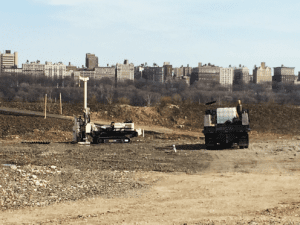Brownfield Redevelopment
 Are you aware of the potential legal and financial liabilities that are associated with brownfield redevelopment? We are here to help you avoid those risks.
Are you aware of the potential legal and financial liabilities that are associated with brownfield redevelopment? We are here to help you avoid those risks.
What is a Brownfield?
A brownfield is a formerly developed property that is about to be redeveloped, but the reconstruction process may be complicated by the presence of a hazardous substance or pollutant.
Brownfield properties can range from closed or under-used industrial facilities, such as an abandoned factory, to a small closed commercial building such as a dry-cleaning establishment or gas station.
One thing these companies may have in common is the potential for high levels of subsurface contaminants generated during their operation. Even a vacant lot may be considered a brownfield due to contaminated fill or illegal dumping of pollutants. Brownfield redevelopment sites have many advantages, including:
- Their prime locations near major population centers and highways
- Existing utility infrastructure
- Deeply discounted prices when compared to virgin properties
However, these advantages come with a lot of risk—risk that could potentially cost more than the value of the property. That risk was born from the passage of the Comprehensive Environmental Response, Compensation, and Liability Act.
Federal Environmental Regulations for Brownfield Redevelopment
CERCLA
In 1980, Congress passed the Comprehensive Environmental Response, Compensation, and Liability Act, otherwise known as CERCLA or Superfund. Through CERCLA, the Environmental Protection Agency (EPA) was given power to seek out those parties responsible for any release of contaminants and assure their cooperation in the cleanup. The courts have applied a strict liability standard under CERCLA. Liability is imposed regardless of fault and can be imposed retroactively (i.e., before CERCLA was enacted). The liability is also joint and several, meaning that liability for contaminants can be imposed regardless of relative contribution, including merely purchasing a property.
Under CERCLA, the EPA can require liable parties to conduct cleanups. The EPA can also conduct a cleanup and subsequently seek cleanup cost recovery from liable parties. CERCLA defines a liable party as:
- The current owner and operator of a contaminated property;
- Any owner or operator at the time of disposal of any hazardous substances;
- Any person who arranged for the disposal or treatment of hazardous substances, or arranged for the transportation of hazardous substances for disposal or treatment;
- Any person who accepts hazardous substances for transport to the property and selects the disposal site.
Brownfields Amendments to CERCLA
In 2002, Congress passed the Small Business Liability Relief and Brownfields Revitalization Act, otherwise known as Brownfields Amendments. These amendments created a new landowner liability protection from CERCLA. The Brownfields Amendments provided liability protection for bona fide prospective purchasers (BFPP) of brownfields properties. To qualify as a BFPP, a person must:
- Not be potentially liable for contamination on or at a property;
- Acquire the property after January 11, 2002;
- Establish that all disposal of hazardous substances occurred before the person acquired the facility;
- Make all appropriate inquiries into previous ownership and uses of the property prior to acquiring the property; and
- Not be affiliated with a party responsible for any contamination.
In order to maintain BFPP status after purchasing a property, landowners must comply with continuing obligations during their property ownership. To comply with the continuing obligations, BFPPs must:
- Provide all legally required notices with respect to the discovery or release of a hazardous substance
- Exercise appropriate care with respect to the hazardous substances by taking reasonable steps to stop or prevent continuing or threatened future releases
- Provide full cooperation, assistance, and access to persons authorized to conduct response actions or natural resource restoration
- Comply with land use restrictions and not impede the effectiveness of institutional controls
- Comply with information requests and subpoenas.
Understanding Brownfield Regulations
With the advent of CERCLA, the financial risk of potentially being held responsible for any future undiscovered pollutants at a former industrial property directed investors toward less risky development opportunities. With former owners bankrupt or deceased, brownfield redevelopment properties sat abandoned. Lenders stayed away because, according to CERCLA, they could be held liable for contamination for merely being associated with such properties.
Past practices at some industrial sites prior to the advent of environmental regulations—which may have been perfectly legal but not necessarily proper—do pose significant cleanup challenges. However, the contamination at some properties may not be overwhelming and there may be tremendous value to be had even with the cost of the cleanup.
The question then became, “How do you mitigate the risk that there is undiscovered contamination for which an investor, lender, or new owner could become liable in the future?”
With the Brownfields Amendments, the All Appropriate Inquiry Rule (AAI) became a means to protect against the risk of potential discovery of contaminants. The AAI Rule does not mean that a new owner is excused from reporting and addressing contamination. Discovered contamination still has to be reported and properly remediated.
Environmental Site Assessments for Brownfields
 The AAI Rule provides an escape from liability called the Innocent Landowner Defense, but this defense can only be used to escape liability if appropriate due diligence was conducted prior to the acquisition of the property. CERCLA allows that appropriate due diligence has been exercised only if a thorough investigation of the site’s current and former uses has been prepared. This investigation is known as an environmental site assessment (ESA).
The AAI Rule provides an escape from liability called the Innocent Landowner Defense, but this defense can only be used to escape liability if appropriate due diligence was conducted prior to the acquisition of the property. CERCLA allows that appropriate due diligence has been exercised only if a thorough investigation of the site’s current and former uses has been prepared. This investigation is known as an environmental site assessment (ESA).
At Ambipar Response EMS, Inc., we break down the ESA into successive phases. Results of the initial phases determine if subsequent phases of investigation are necessary.
Phase I Environmental Site Assessment
The ESA process is rigorously outlined by the American Society of Testing and Materials (ASTM). The first step in the process is a Phase I Environmental Site Assessment.
The Phase I ESA includes research on current and former uses of the land, collection of documents relevant to the property, and a non-invasive inspection of the site to determine the possibility of contamination on the property. The goal of a Phase I ESA is to determine if there is anything on the site that will require further investigation.
For example, if an underground storage tank (UST) were to be located, the Phase I report would recommend the need for further investigation to determine if the UST had leaked. An additional example would be if a drain from a parts-washing area was identified, the Phase I would recommend the need for further investigation to determine where the fluids were discharged and if soil or groundwater was impacted.
For more information about Phase I ESAs, please read these articles:
How Much Does a Phase I Environmental Site Assessment Cost?
Is a Phase I Necessary for Every Commercial Property Purchase?
Phase II Environmental Site Assessment
The second step in the process is a Phase II Environmental Site Assessment.
The purpose of the Phase II ESA is to resolve the issues presented by the Phase I report as in the examples above.
If contamination is discovered, the nature and extent of contamination will be delineated on the property. This is a much more invasive process than the Phase I ESA and can include geophysical analysis, excavation, drilling, as well as sampling and analysis of soil and groundwater.
For more information regarding Phase II ESAs, please read:
How Much Does a Phase II Environmental Site Assessment Cost?
Phase III Environmental Site Assessment
The discovery of contamination on the property may trigger the need for the third step in the process—a Phase III Environmental Site Assessment or a detailed plan for the remediation of the site. Depending upon the nature and extent of contamination, there may be a wide range of technologies that can be employed to achieve remediation goals for the site.
For more information regarding remediation for your site, please read How Much Does a Remedial Action Plan Cost?
CERCLA’s retroactive liability has made the performance of an ESA a practical necessity for any potential buyer of property who does not want to assume liability for the cleanup of any contaminants found at the brownfield redevelopment property. However, these brownfields are often in prime locations and may be obtained at greatly reduced costs.
Ambipar Response EMS has assessed hundreds of sites to protect our clients from potential legal and financial ramifications of brownfield redevelopment. Our licensed professionals follow a multi-step process to efficiently assist our clients in the critical decision-making steps when acquiring brownfield properties. The steps in this process are standardized because of the need for accurate information to plan development as well as to withstand the scrutiny of the EPA’s Brownfields regulations.
We provide the experience and technology to:
- Investigate the potential presence of contaminants (Phase I ESAs)
- Identify the type of and extent of contaminants (Phase II ESAs)
- Design a remedy to address contamination (Phase III ESAs/Remedial Action Plans)
- Provide cleanup cost estimates
- Implement a remedy for the contamination.


